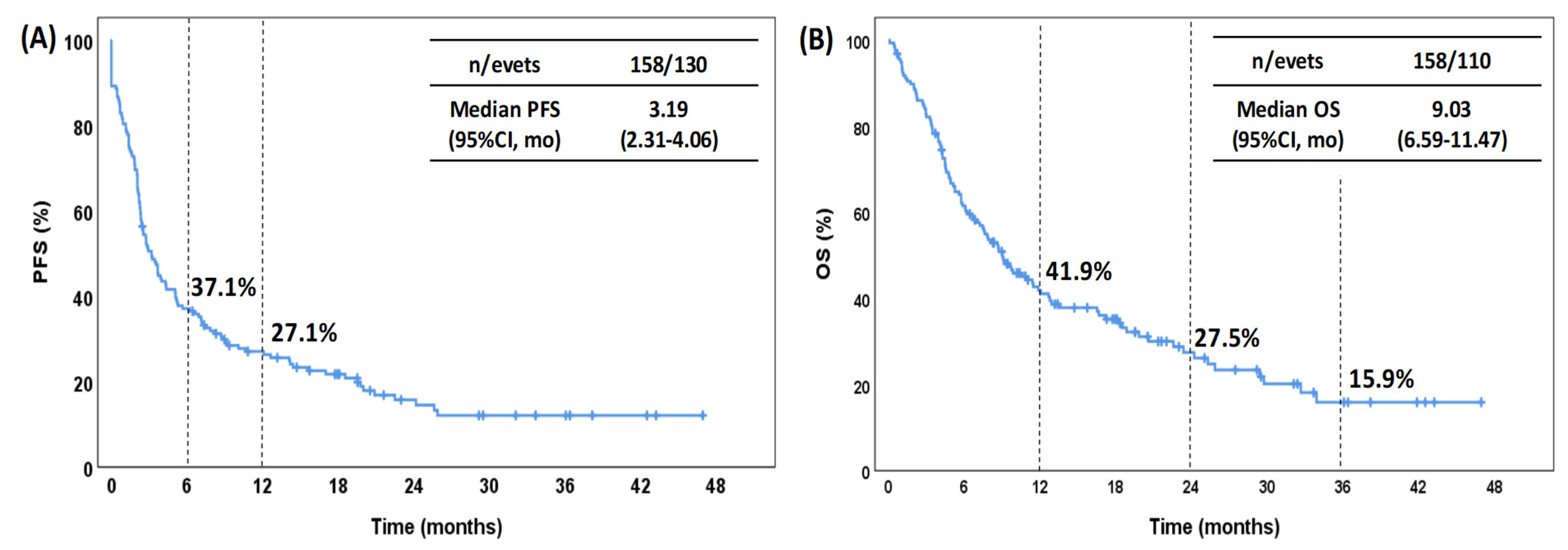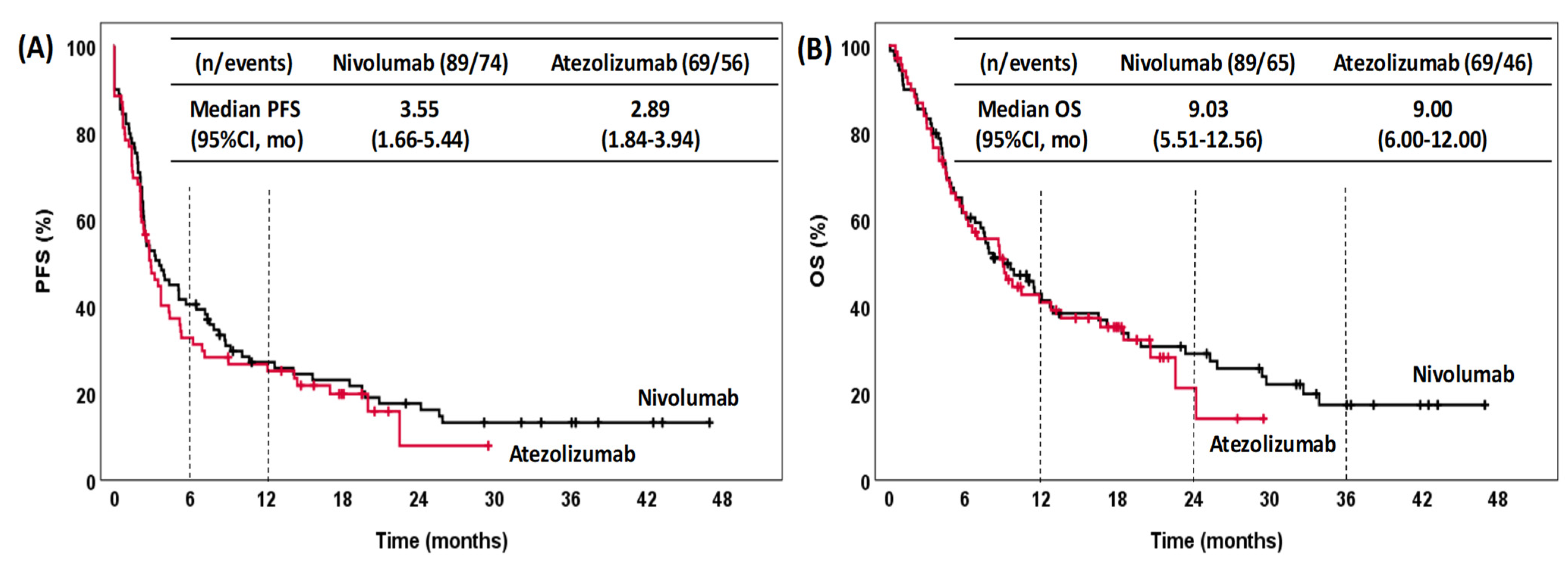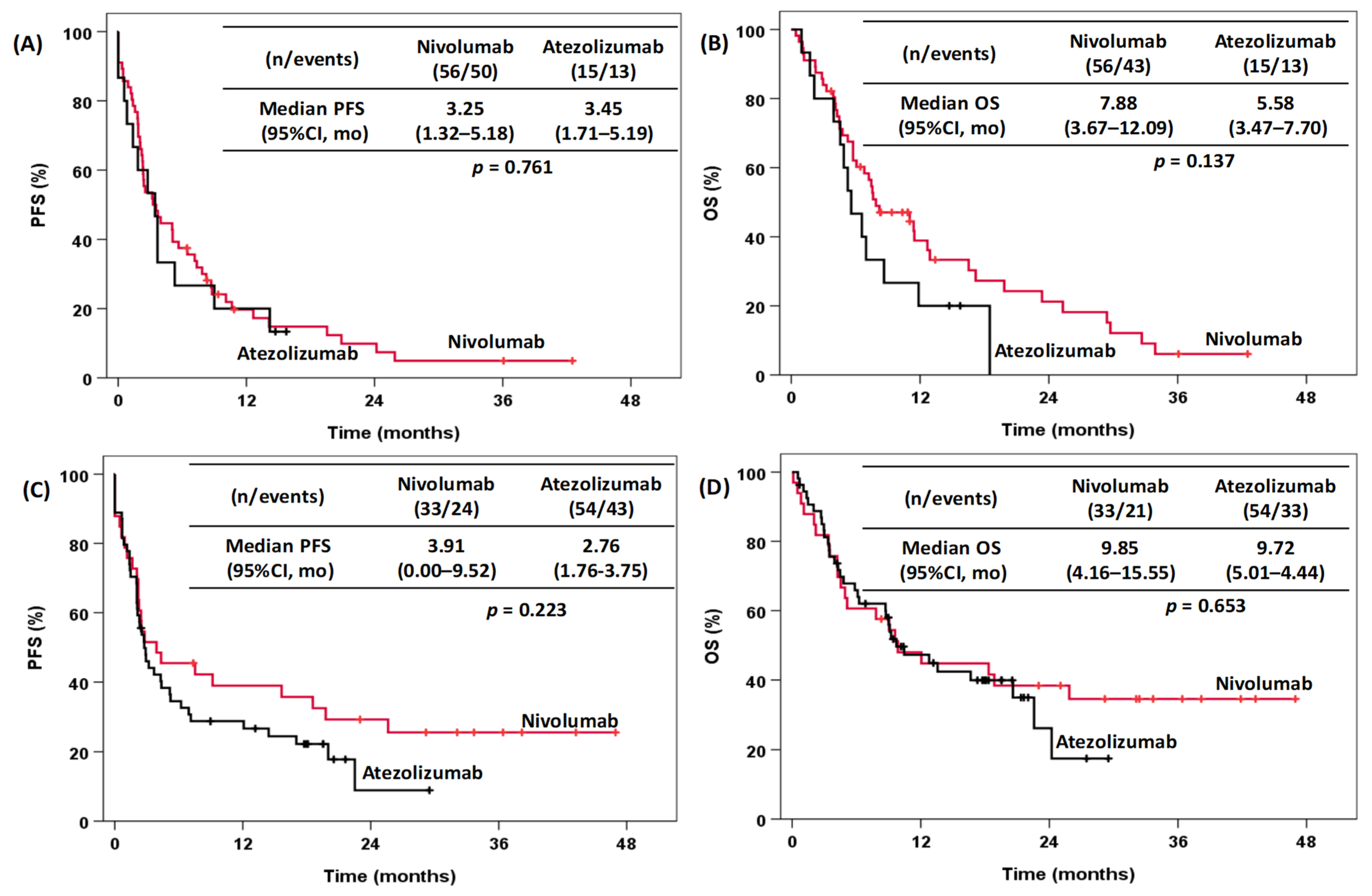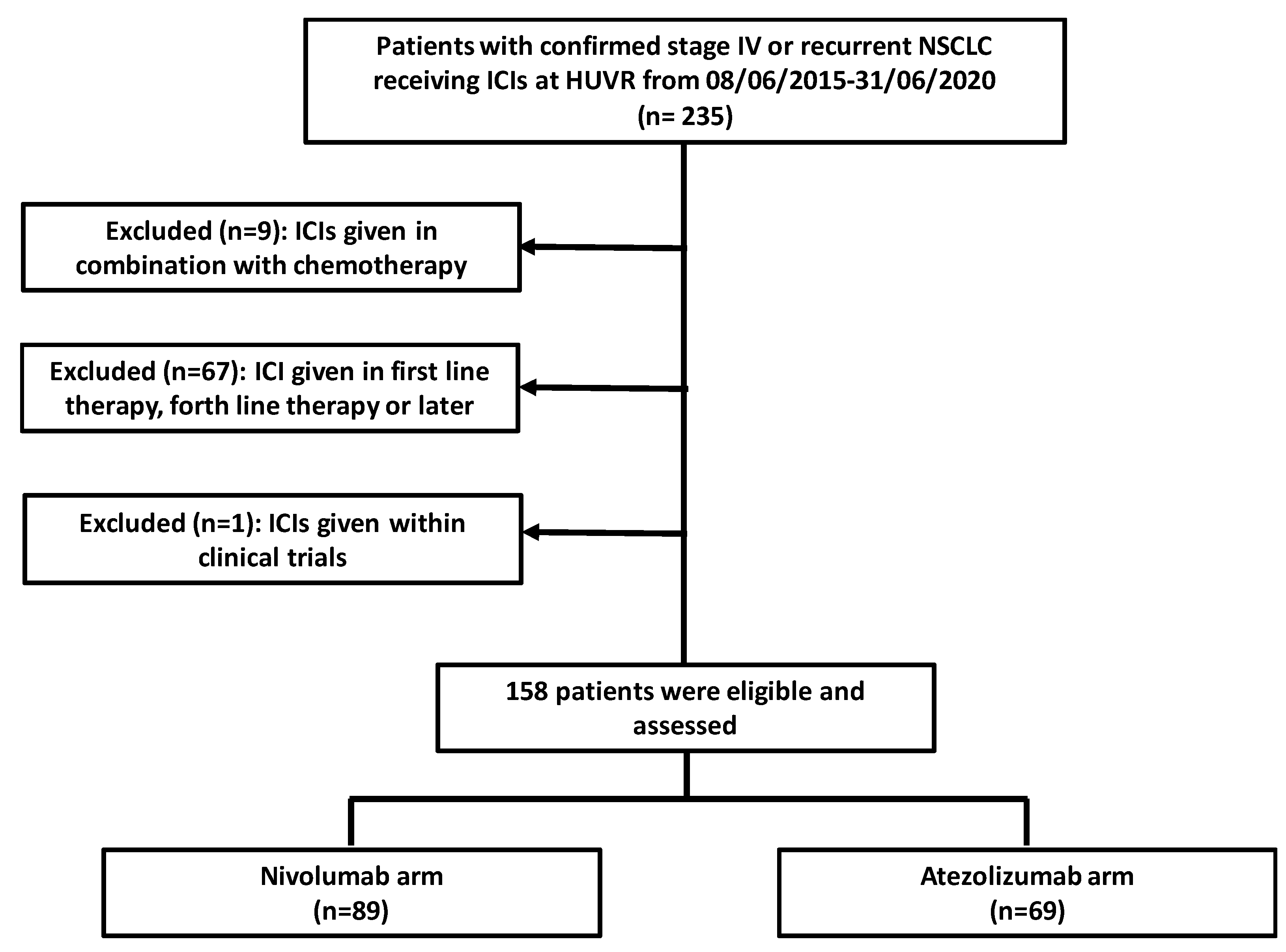Real-World Analysis of Nivolumab and Atezolizumab Efficacy in Previously Treated Patients with Advanced Non-Small Cell Lung Cancer
Abstract
:1. Introduction
2. Results
2.1. Patient Characteristics
2.2. Efficacy Outcomes
2.3. Survival Outcomes
Survival Analysis According to Histological Subtype (Squamous versus Nonsquamous)
2.4. Safety Outcomes
3. Discussion
4. Materials and Methods
4.1. Patients and Study Design
4.2. Statistical Analysis
5. Conclusions
Supplementary Materials
Author Contributions
Funding
Institutional Review Board Statement
Informed Consent Statement
Data Availability Statement
Conflicts of Interest
References
- Bray, F.; Ferlay, J.; Soerjomataram, I.; Siegel, R.L.; Torre, L.A.; Jemal, A. Global cancer statistics 2018: GLOBOCAN estimates of incidence and mortality worldwide for 36 cancers in 185 countries. CA Cancer J. Clin. 2018, 68, 394–424. [Google Scholar] [CrossRef] [PubMed] [Green Version]
- Zhao, Y.; Liu, L.; Weng, L. Comparisons of Underlying Mechanisms, Clinical Efficacy and Safety between Anti-PD-1 and Anti-PD-L1 Immunotherapy: The State-of-the-Art Review and Future Perspectives. Front. Pharmacol. 2021, 12, 714483. [Google Scholar] [CrossRef] [PubMed]
- Brahmer, J.; Reckamp, K.L.; Baas, P.; Crinò, L.; Eberhardt, W.E.E.; Poddubskaya, E.; Antonia, S.; Pluzanski, A.V.; Everett, E.; Holgado, E.; et al. Nivolumab versus docetaxel in advanced squamous-cell non-small-cell lung cancer. N. Engl. J. Med. 2015, 373, 123–135. [Google Scholar] [CrossRef] [PubMed] [Green Version]
- Borghaei, H.; Paz-Ares, L.; Horn, L.; Spigel, D.R.; Steins, M.; Ready, N.E.; Chow, L.Q.; Vokes, E.E.; Felip, E.; Holgado, E.; et al. Nivolumab versus docetaxel in advanced nonsquamous non-small-cell lung cancer. N. Engl. J. Med. 2015, 373, 1627–1639. [Google Scholar] [CrossRef] [PubMed]
- Herbst, R.S.; Baas, P.; Kim, D.W.; Felip, E.; Pérez-Gracia, J.L.; Han, J.Y.; Molina, J.; Kim, J.H.; Arvis, C.D.; Ahn, M.J.; et al. Pembrolizumab versus docetaxel for previously treated, PD-L1-positive, advanced non-small-cell lung cancer (KEYNOTE-010): A randomised controlled trial. Lancet 2016, 387, 1540–1550. [Google Scholar] [CrossRef]
- Rittmeyer, A.; Barlesi, F.; Waterkamp, D.; Park, K.; Ciardiello, F.; von Pawel, J.; Gadgeel, S.M.; Hida, T.; Kowalski, D.M.; Dols, M.C.; et al. Atezolizumab versus docetaxel in patients with previously treated non-small-cell lung cancer (OAK): A phase 3, open-label, multicentre randomised controlled trial. Lancet 2017, 389, 255–265. [Google Scholar] [CrossRef]
- Socinski, M.A.; Obasaju, C.; Gandara, D.; Hirsch, F.R.; Bonomi, P.; Bunn, P.; Kim, E.S.; Langer, C.J.; Natale, R.B.; Novello, S.; et al. Clinicopathologic features of advanced squamous NSCLC. J. Thorac. Oncol. 2016, 11, 1411–1422. [Google Scholar] [CrossRef] [Green Version]
- Mencoboni, M.; Ceppi, M.; Bruzzone, M.; Taveggia, P.; Cavo, A.; Scordamaglia, F.; Gualco, M.; Filiberti, R.A. Effectiveness and safety of immune checkpoint inhibitors for patients with advanced non small-cell lung cancer in real-world: Review and meta-analysis. Cancers 2021, 13, 1388. [Google Scholar] [CrossRef]
- Barlesi, F.; Dixmier, A.; Debieuvre, D.; Raspaud, C.; Auliac, J.B.; Benoit, N.; Bombaron, P.; Moro-Sibilot, D.; Audigier-Valette, C.; Asselain, B.; et al. Effectiveness and safety of nivolumab in the treatment of lung cancer patients in France: Preliminary results from the real-world EVIDENS study. Oncoimmunology 2020, 9, e1744898. [Google Scholar] [CrossRef] [Green Version]
- Furuya, N.; Nishino, M.; Wakuda, K.; Ikeda, S.; Sato, T.; Ushio, R.; Tanzawa, S.; Sata, M.; Ito, K. Real-world efficacy of atezolizumab in non-small cell lung cancer: A multicenter cohort study focused on performance status and retreatment after failure of anti-PD-1 antibody. Thorac. Cancer 2021, 12, 613–618. [Google Scholar] [CrossRef]
- Ramagopalan, S.; Gupta, A.; Arora, P.; Thorlund, K.; Ray, J.; Subbiah, V. Comparative Effectiveness of Atezolizumab, Nivolumab, and Docetaxel in Patients with Previously Treated Non–Small Cell Lung Cancer. JAMA Netw. Open 2021, 4, e2134299. [Google Scholar] [CrossRef] [PubMed]
- Weis, T.M.; Hough, S.; Reddy, H.G.; Daignault-Newton, S.; Kalemkerian, G.P. Real-world comparison of immune checkpoint inhibitors in non-small cell lung cancer following platinum-based chemotherapy. J. Oncol. Pharm. Pract. 2020, 26, 564–571. [Google Scholar] [CrossRef] [PubMed]
- Ivanović, M.; Knez, L.; Herzog, A.; Kovačević, M.; Cufer, T. Immunotherapy for Metastatic Non-Small Cell Lung Cancer: Real-World Data from an Academic Central and Eastern European Center. Oncologist 2021, 26, e2143–e2150. [Google Scholar] [CrossRef] [PubMed]
- Figueiredo, A.; Almeida, M.A.; Almodovar, M.T.; Alves, P.; Araújo, A.; Araújo, D.; Barata, F.; Barradas, L.; Barroso, A.; Brito, U.; et al. Real-world data from the Portuguese Nivolumab Expanded Access Program (EAP) in previously treated Non Small Cell Lung Cancer (NSCLC). Pulmonology 2020, 26, 10–17. [Google Scholar] [CrossRef]
- Chen, M.; Li, Q.; Xu, Y.; Zhao, J.; Zhang, L.; Wei, L.; Zhong, W.; Wang, M. Immunotherapy as second-line treatment and beyond for non-small cell lung cancer in a single center of China: Outcomes, toxicities, and clinical predictive factors from a real-world retrospective analysis. Thorac. Cancer 2020, 11, 1955–1962. [Google Scholar] [CrossRef]
- Martin, C.; Lupinacci, L.; Perazzo, F.; Bas, C.; Carranza, O.; Puparelli, C.; Kowalyszyn, R.; Magri, I.; Varela, M.; Richardet, E.; et al. Efficacy and Safety of Nivolumab in Previously Treated Patients with Non–Small-cell Lung Cancer: Real World Experience in Argentina. Clin. Lung Cancer 2020, 21, e380–e387. [Google Scholar] [CrossRef] [PubMed]
- El Karak, F.; Gh Haddad, F.; Eid, R.; Al Ghor, M.; El Rassy, E.; Ahmadieh, N.; Choullamy, T.; Halim, N.A.; Tfayli, A.; Farhat, F.; et al. Lung cancer and immunotherapy: A real-life experience from second line and beyond. Future Oncol. 2019, 15, 3025–3032. [Google Scholar] [CrossRef]
- Schvartsman, G.; Peng, S.A.; Bis, G.; Lee, J.J.; Benveniste, M.F.K.; Zhang, J.; Roarty, E.B.; Lacerda, L.; Swisher, S.; Heymach, J.V.; et al. Response rates to single-agent chemotherapy after exposure to immune checkpoint inhibitors in advanced non-small cell lung cancer. Lung Cancer 2017, 112, 90–95. [Google Scholar] [CrossRef]
- Yano, Y.; Kurebe, H.; Edahiro, R.; Hosono, Y.; Nakatsubo, S.; Nishida, K.; Sawa, N.; Ishijima, M.; Uenami, T.; Kanazu, M.; et al. Post-progression survival after cessation of treatment with nivolumab for advanced non-small cell lung cancer: A retrospective study. PLoS ONE 2018, 13, e0203070. [Google Scholar]
- Gettinger, S.; Horn, L.; Jackman, D.; Spigel, D.; Antonia, S.; Hellmann, M.; Powderly, J.; Heist, R.; Sequist, L.V.; Smith, D.C.; et al. Five-year follow-up of nivolumab in previously treated advanced non–small-cell lung cancer: Results from the CA209-003 study. J. Clin. Oncol. 2018, 36, 1675–1684. [Google Scholar] [CrossRef]
- Mazieres, J.; Rittmeyer, A.; Gadgeel, S.; Hida, T.; Gandara, D.R.; Cortinovis, D.L.; Barlesi, F.; Yu, W.; Matheny, C.; Ballinger, M.; et al. Atezolizumab Versus Docetaxel in Pretreated Patients with NSCLC: Final Results from the Randomized Phase 2 POPLAR and Phase 3 OAK Clinical Trials. J. Thorac. Oncol. 2021, 16, 140–150. [Google Scholar] [CrossRef] [PubMed]
- Dudnik, E.; Moskovitz, M.; Daher, S.; Shamai, S.; Hanovich, E.; Grubstein, A.; Shochat, T.; Wollner, M.; Bar, J.; Merimsky, O.; et al. Effectiveness and safety of nivolumab in advanced non-small cell lung cancer: The real-life data. Lung Cancer 2018, 126, 217–223. [Google Scholar] [CrossRef] [PubMed]
- Montana, M.; Garcia, M.-E.; Ausias, N.; Jeanpierre, M.; Meiffren, M.; Giorgi, R.; Vanelle, P.; Barlesi, F. Efficacy and safety of nivolumab in patients with non-small cell lung cancer: A retrospective study in clinical practice. J. Chemother. 2019, 31, 90–94. [Google Scholar] [CrossRef] [PubMed]
- Ahn, B.-C.; Pyo, K.-H.; Xin, C.-F.; Jung, D.; Shim, H.S.; Lee, C.Y.; Park, S.-Y.; Yoon, H.-I.; Hong, M.-H.; Cho, B.-C.; et al. Comprehensive analysis of the characteristics and treatment outcomes of patients with non-small cell lung cancer treated with anti-PD-1 therapy in real-world practice. J. Cancer Res. Clin. Oncol. 2019, 145, 1613–1623. [Google Scholar] [CrossRef] [Green Version]
- Knetki-Wróblewska, M.; Kowalski, D.M.; Krzakowski, M. Nivolumab for Previously Treated Patients with Non-Small-Cell Lung Cancer-Daily Practice versus Clinical Trials. J. Clin. Med. 2020, 9, 2273. [Google Scholar] [CrossRef]
- Passiglia, F.; Galvano, A.; Rizzo, S.; Incorvaia, L.; Listì, A.; Bazan, V.; Russo, A. Looking for the best immune-checkpoint inhibitor in pre-treated NSCLC patients: An indirect comparison between nivolumab, pembrolizumab and atezolizumab. Int. J. Cancer 2018, 142, 1277–1284. [Google Scholar] [CrossRef] [Green Version]
- Liang, J.; Li, M.; Sui, Q.; Hu, Z.; Bian, Y.; Huang, Y.; Zhan, C.; Jiang, W.; Wang, Q.; Tan, L. Compare the efficacy and safety of programmed cell death-1 (PD-1) and programmed cell death ligand-1 (PD-L1) inhibitors for advanced non-small cell lung cancer: A Bayesian analysis. Transl. Lung Cancer Res. 2020, 9, 1302–1323. [Google Scholar] [CrossRef]
- Joris, S.; Pieters, T.; Sibille, A.; Bustin, F.; Jacqmin, L.; Kalantari, H.R.; Surmont, V.; Goeminne, J.-C.; Clinckart, F.; Pat, K.; et al. Real life safety and effectiveness of nivolumab in older patients with non-small cell lung cancer: Results from the Belgian compassionate use program. J. Geriatr. Oncol. 2020, 11, 796–801. [Google Scholar] [CrossRef]
- Manrique, M.C.A.; Martínez, J.M.; González, J.G.; Afonso, F.J.A.; Quintela, M.L.; Núñez, N.F.; Raposeiras, C.A.; Gancedo, M.A.; Couto, L.S.; Campelo, M.R.G.; et al. Real world data of nivolumab for previously treated non-small cell lung cancer patients: A Galician lung cancer group clinical experience. Transl. Lung Cancer Res. 2018, 7, 404–415. [Google Scholar] [CrossRef]
- Juergens, R.A.; Mariano, C.; Jolivet, J.; Finn, N.; Rothenstein, J.; Reaume, M.N.; Faghih, A.; Labbé, C.; Owen, S.; Shepherd, F.A.; et al. Real-world benefit of nivolumab in a Canadian non-small-cell lung cancer cohort. Curr. Oncol. 2018, 25, 384–392. [Google Scholar] [CrossRef] [Green Version]
- Zhang, G.; Cheng, R.; Wang, H.; Zhang, Y.; Yan, X.; Li, P.; Zhang, M.; Zhang, X.; Yang, J.; Niu, Y.; et al. Comparable outcomes of nivolumab in patients with advanced NSCLC presenting with or without brain metastases: A retrospective cohort study. Cancer Immunol. Immunother. 2020, 69, 399–405. [Google Scholar] [CrossRef] [PubMed]
- Duan, J.; Cui, L.; Zhao, X.; Bai, H.; Cai, S.; Wang, G.; Zhao, Z.; Zhao, J.; Chen, S.; Song, J.; et al. Use of Immunotherapy with Programmed Cell Death 1 vs. Programmed Cell Death Ligand 1 Inhibitors in Patients with Cancer: A Systematic Review and Meta-analysis. JAMA Oncol. 2020, 6, 375–384. [Google Scholar] [CrossRef] [PubMed]
- Eisenhauer, E.A.; Therasse, P.; Bogaerts, J.; Schwartz, L.H.; Sargent, D.; Ford, R.; Dancey, J.; Arbuck, S.; Gwyther, S.; Mooney, M.; et al. New response evaluation criteria in solid tumours: Revised RECIST guideline (version 1.1). Eur. J. Cancer 2009, 45, 228–247. [Google Scholar] [CrossRef] [PubMed]




| Study | Treatment | Line | Population % | Patients n | Age, Median (Range) | ECOG ≥ 2 n (%) | CNS Met n (%) | PFS (Months) | OS (Months) | ORR (%) |
|---|---|---|---|---|---|---|---|---|---|---|
| Checkmate 017 [3] | Nivo | ≥2 | Squamous | 135 | 62 (39–85) | 2 (1.5) | 9 (6.6) | 3.5 | 9.2 | 20 |
| Checkmate 057 [4] | Nivo | ≥2 | Non-sq | 292 | 61 (37–84) | 0 | 34 (11.6) | 2.3 | 12.2 | 19 |
| OAK [6] | Atezo | ≥2 | Sq: 26 Non-sq: 74 | 425 | 63 (33–82) | 0 | 85 (10.0) a | 2.8 | 13.8 | 14 |
| Ramagopalan et al., (2021) (USA) [11] | Nivo Atezo | 1.31 1.35 b | Sq: 30.82 Non-sq: 65.55 Other: 3.63 | 2630 206 | 67.28 (mean) 68.30 (mean) | 739 (28.1) 50 (24.3) | 191 (7.3) 37 (18) | nr | HR: 1.04 (95% CI: 0.88–1.24) | nr |
| Weis et al., (2020) (USA) [12] | Atezo Nivo | ≥2 | Sq: 30.65 Non-sq: 62.90 Other: 6.45 | 43 81 | 67.2 (nr) 64.3 (nr) | 9 (20.9) 21 (28.4) | nr | 2.0 2.2 | 6.5 8.4 | 13.9 14.8 |
| Ivanovic et al., (2021) (Slovenia) [13] | Nivo, Atezo, Pembro. | 2 | Sq: 15 Non-sq: 85 | 40 | 63 (42–77) | 1 (3.0) | 8 (20.0) | 3.5 | 9.9 | 25 |
| Figueiredo et al., (2020) (Portugal) [14] | Nivo | ≥2 | Sq: 12 Non-sq: 88 | 219 | 64 (37–83) | 29 (13.2) | nr | 4.9 | 13.2 | 22.4 |
| Chen et al., (2020) (China) [15] | Nivo Pembro. | ≥2 | Sq: 40 Non-sq: 60 | 62 35 | 64 (IQR:57–69) | nr (15) | nr | 5 | 18 | 16.5 |
| Martin et al., (2020) (Argentina) [16] | Nivo | ≥1 | Sq: 20.2 Non-sq: 78 Other: 1.8 | 109 | 65 (56–72) | 17 (15.6) | nr | 6.1 | 12.1 | 28.57 |
| Furuya et al., (2021) (Japan) c [10] | Atezo | ≥1 | Sq: 13.16 ADC: 80.26 Other: 6.58 | 152 | 71 (43–93) | 8 (5.26) | 39 (25.65) | 1.4 | 12.8 | 8.6 |
| Barlesi et al., (2020) (France) [9] | Nivo | ≥1 d | Sq: 30.8 Non-sq: 69.2 | 1420 | 66 (35–91) | 241 (17.1) | 282 (19.9) | 2.8 | 11.2 | 19.6 |
| El Karak et al., (2019) (Lebanon) [17] | Nivo Pembro | ≥2 | Sq: 30 ADC: 57 Other: 13 | 55 55 | 66 (nr) | nr | 17 (15.5) | 4 | 8.1 | 25 |
| Current study | Whole Cohort | 2–3 | Sq: 44.9 Non-sq: 55.1 | 158 | 64 (37–86) | 24 (15.2) | 26 (16.5) | 3.19 | 9.03 | 19 |
| Nivo | 89 | 66 (37–86) | 14 (15.7) | 10 (11.2) | 3.55 | 9.03 | 22.50 | |||
| Atezo | 69 | 62 (40–80) | 10 (15.5) | 16 (23.2) | 2.89 | 9.00 | 14.49 |
| Characteristic n (%) | All Patients (n = 158) | Nivolumab (n = 89) | Atezolizumab (n = 69) | p Value |
|---|---|---|---|---|
| Age. median (range). years | 64 (37–86) | 66 (37–86) | 62 (40–80) | 0.005 ‡ |
| Binary age at ICI initiation | 0.013 * | |||
| ≤65 | 90 (57) | 43 (48.3) | 47 (68.1) | |
| >65 | 68 (43) | 46 (51.7) | 22 (31.9) | |
| Sex | 0.401 * | |||
| Male | 124 (78.5) | 72 (80.9) | 52 (75.4) | |
| Female | 34 (21.5) | 17 (19.1) | 17 (24.6) | |
| ECOG score at ICI initiation | 0.830 * | |||
| 0–1 | 134 (84.8) | 75 (84.3) | 59 (85.5) | |
| ≥2 | 24 (15.2) | 14 (15.7) | 10 (15.5) | |
| Histology | <0.001 * | |||
| Squamous | 71 (44.9) | 56 (62.9) | 15 (21.7) | |
| Non-squamous | 87 (55.1) | 33 (37.1) | 54 (78.3) | |
| CNS metastasis | 26 (16.5) | 10 (11.2) | 16 (23.2) | 0.044 * |
| COPD | 45 (28.8) | 26 (29.2) | 19 (27.5) | 0.817 * |
| PD-L1 (positive ≥ 1% tumour cells) | <0.001 * | |||
| Yes | 60 (38.0) | 27 (30.3) | 33 (47.8) | |
| No | 37 (23.4) | 13 (14.6) | 24 (34.8) | |
| Unknown | 61 (38.6) | 49 (55.1) | 12 (17.4) | |
| Smoking status | 0.184 * | |||
| Never or +10 years former smokers | 42 (26.6) | 20 (22.5) | 22 (31.9) | |
| Current or −10 years former smokers | 116 (73.4) | 69 (77.5) | 47 (68.1) | |
| Treatment lines | 0.157 * | |||
| 2 | 125 (79.1) | 74 (83.1) | 51 (73.9) | |
| 3 | 33 (20.9) | 15 (16.9) | 18 (26.1) | |
| Initial Platinum therapy | 1 † | |||
| Yes | 150 (94.9) | 84 (94.4) | 66 (95.7) | |
| No | 8 (5.1) | 5 (5.6) | 3 (4.3) | |
| Follow-up (95% CI, mo) | 8.32 (0.10–46.95) | 8.21 (0.10–46.95) | 8.7 (0.53–29.50) | 0.303 ” |
| Treatment—n (%) | All Patients (n = 158) | Nivolumab (n = 89) | Atezolizumab (n = 69) |
|---|---|---|---|
| No subsequent therapy | 95 (60.1) | 59 (66.3) | 36 (52.2) |
| Carboplatin combination | 8 (5.1) | 5 (5.6) | 3 (4.3) |
| Cisplatin combination | 2 (1.3) | 1 (1.1) | 1 (1.4) |
| Docetaxel | 22 (13.9) | 9 (10.1) | 13 (18.8) |
| Erlotinib | 1 (0.6) | 1 (1.1) | 0 |
| Gemcitabine | 5 (3.2) | 4 (4.5) | 1 (1.4) |
| Pemetrexed | 2 (1.3) | 0 | 2 (2.9) |
| Vinorelbine | 23 (14.6) | 10 (11.2) | 13 (18.8) |
| Response n (% [95% CI]) | All Patients (n = 158) | Nivolumab (n = 89) | Atezolizumab (n = 69) | p Value |
|---|---|---|---|---|
| ORR | 30 (19 [12.8–25.3]) | 20 (22.5 [13.6–31.3]) | 10 (14.5 [6.0–23.3]) | 0.140 * |
| DCR | 69 (43.7 [36.1–51.8]) | 44 (49.4[38.8–60.0]) | 25 (36.2 [25.0–40.5]) | 0.113 * |
| Complete response | 3 (1.9) | 3 (3.4) | 0 | |
| Partial Response | 27 (17.1) | 17 (19.1) | 10 (14.5) | |
| Stable disease | 39 (24.7) | 24 (26.9) | 15 (21.7) | |
| Progressive disease | 88 (55.7 [48.2–63.9]) | 45 (50.6 [40.0–61.1]) | 43 (62.3 [51.1–75.0]) | |
| Unable to assess | 1 (0.6) | 0 | 1 (1.5) |
| Parameter | Category | PFS | OS | ||||
|---|---|---|---|---|---|---|---|
| HR | 95% CI | p Value | HR | 95% CI | p Value | ||
| Age | ≤65 vs. >65 | 1.17 | 0.83–1.66 | 0.372 | 1.04 | 0.71–1.52 | 0.835 |
| Sex | Female vs. Male | 0.97 | 0.64–1.49 | 0.901 | 0.83 | 0.52–1.34 | 0.454 |
| Histology | Squamous vs. non-squamous | 1.28 | 0.90–1.81 | 0.162 | 1.48 | 1.02–2.16 | 0.040 * |
| CNS metastasis | No vs. Yes | 0.86 | 0.55–1.36 | 0.529 | 1.13 | 0.67–1.90 | 0.637 |
| ECOG score | 0–1 vs. ≥2 | 0.48 | 0.29–0.77 | 0.003* | 0.38 | 0.22–0.64 | <0.001 * |
| PDL1 | − vs. + | 1.33 | 0.84–2.09 | 0.223 | 1.09 | 0.65–1.81 | 0.745 |
| Unknown vs. + | 0.94 | 0.63–1.41 | 0.779 | 0.95 | 0.62–1.47 | 0.829 | |
| Smoking status | Never or +10 years former smokers | 1.16 | 0.79–1.71 | 0.450 | 1.20 | 0.79–1.84 | 0.397 |
| Treatment | Nivo vs. Atezo | 0.89 | 0.62–1.26 | 0.500 | 0.92 | 0.63–1.36 | 0.685 |
| Line of therapy | 2 vs. 3 | 0.85 | 0.57–1.28 | 0.442 | 0.94 | 0.60–1.47 | 0.801 |
| Initial platinum therapy | No vs. Yes | 0.49 | 0.18–1.32 | 0.157 | 0.63 | 0.24–1.81 | 0.422 |
| Parameter | Category | PFS | OS | ||||
|---|---|---|---|---|---|---|---|
| HR | 95% CI | p Value | HR | 95% CI | p Value | ||
| Treatment | Nivo vs. Atezo | 0.80 | 0.55–1.17 | 0.260 | 0.79 | 0.52–1.21 | 0.281 |
| Histology | Squamous vs. non-squamous | 1.40 | 0.96–2.04 | 0.080 | 1.68 | 1.12–2.53 | 0.012 * |
| ECOG | 0–1 vs. ≥2 | 0.49 | 0.30–0.79 | 0.004 * | 0.37 | 0.22–0.63 | <0.001 * |
| n° of Events (% of Patients Affected) | Total | Nivolumab | Atezolizumab | ||||
|---|---|---|---|---|---|---|---|
| Any Grade | Grade 3–5 | Any Grade | Grade 3–5 | Any Grade | Grade 3–5 | p Value | |
| Any event | 243 (64.55) | 23 (14.55) | 166 (76.4) | 17 (19.10) | 77 (49.3) | 6 (8.69) | <0.001 |
| Led to temporary drug discontinuation | 31 (19.00) | 18 (11.39) | 24 (25.84) | 15 (16.85) | 7 (10.14) | 3 (4.34) | 0.243 |
| Led to definitive drug discontinuation | 15 (9.49) | 10 (6.32) | 10 (11.23) | 7 (7.86) | 5 (7.24) | 3 (4.35) | 0.270 |
| Anorexia | 21 (13.29) | 1 (0.63) | 16 (17.98) | 0 (0) | 5 (7.24) | 1 (1.45) | |
| Arthralgia * | 15 (9.49) | 0 | 9 (10.11) | 0 (0) | 6 (8.69) | 0 (0) | |
| Asthenia/Fatigue | 70 (44.30) | 2 (1.26) | 48 (53.93) | 1 (1.12) | 22 (31.88) | 1 (1.45) | |
| Diarrhoea * | 13 (8.23) | 0 | 8 (9.00) | 0 (0) | 5 (7.24) | 0 (0) | |
| Hepatotoxicity * | 5 (3.16) | 2 (1.26) | 3 (3.37) | 1 (1.12) | 2 (2.90) | 1(1.45) | |
| Sickness | 14 (8.86) | 0 | 10 (11.23) | 0 (0) | 4 (5.80) | 0 (0) | |
| Pneumonitis * | 10 (6.33) | 5 (3.16) | 8 (9.00) | 4 (4.49) | 2 (2.90) | 1 (1.45) | |
| Thyroid dysfunction * | 5 (3.16) | 0 | 3 (3.37) | 0 (0) | 2 (2.90) | 0 (0) | |
| Skin disorder * | 43 (27.22) | 1 (1.26) | 30 (33.70) | 1 (1.12) | 13 (18.84) | 0 (0) | |
| Pruritus | 15 (9.49) | 0 | 10 (11.23) | 0 (0) | 5 (7.24) | 0 (0) | |
| RASH | 20 (12.66) | 1 (1.26) | 15 (16.85) | 1 (1.12) | 5 (7.24) | 0 (0) | |
| Vomiting | 8 (5.06) | 0 | 4 (4.49) | 0 (0) | 4 (5.80) | 0 (0) | |
| Other ‡ | 30 (18.35) | 5 (3.16) | 19 (21.34) | 4 (4.49) | 11 (14.49) | 1 (1.45) | |
Publisher’s Note: MDPI stays neutral with regard to jurisdictional claims in published maps and institutional affiliations. |
© 2022 by the authors. Licensee MDPI, Basel, Switzerland. This article is an open access article distributed under the terms and conditions of the Creative Commons Attribution (CC BY) license (https://creativecommons.org/licenses/by/4.0/).
Share and Cite
Alonso-García, M.; Sánchez-Gastaldo, A.; Muñoz-Fuentes, M.A.; Molina-Pinelo, S.; Boyero, L.; Benedetti, J.C.; Bernabé-Caro, R. Real-World Analysis of Nivolumab and Atezolizumab Efficacy in Previously Treated Patients with Advanced Non-Small Cell Lung Cancer. Pharmaceuticals 2022, 15, 533. https://doi.org/10.3390/ph15050533
Alonso-García M, Sánchez-Gastaldo A, Muñoz-Fuentes MA, Molina-Pinelo S, Boyero L, Benedetti JC, Bernabé-Caro R. Real-World Analysis of Nivolumab and Atezolizumab Efficacy in Previously Treated Patients with Advanced Non-Small Cell Lung Cancer. Pharmaceuticals. 2022; 15(5):533. https://doi.org/10.3390/ph15050533
Chicago/Turabian StyleAlonso-García, Miriam, Amparo Sánchez-Gastaldo, Miguel A. Muñoz-Fuentes, Sonia Molina-Pinelo, Laura Boyero, Johana Cristina Benedetti, and Reyes Bernabé-Caro. 2022. "Real-World Analysis of Nivolumab and Atezolizumab Efficacy in Previously Treated Patients with Advanced Non-Small Cell Lung Cancer" Pharmaceuticals 15, no. 5: 533. https://doi.org/10.3390/ph15050533
APA StyleAlonso-García, M., Sánchez-Gastaldo, A., Muñoz-Fuentes, M. A., Molina-Pinelo, S., Boyero, L., Benedetti, J. C., & Bernabé-Caro, R. (2022). Real-World Analysis of Nivolumab and Atezolizumab Efficacy in Previously Treated Patients with Advanced Non-Small Cell Lung Cancer. Pharmaceuticals, 15(5), 533. https://doi.org/10.3390/ph15050533







